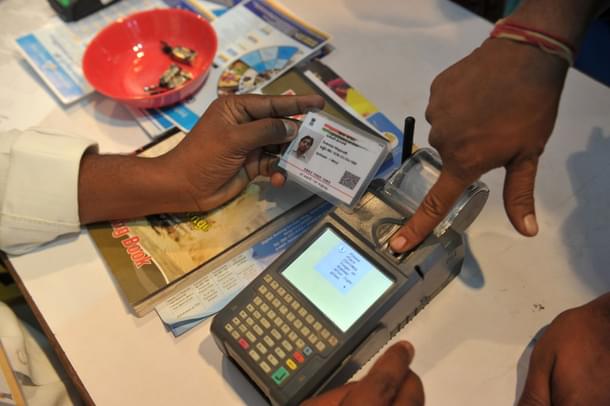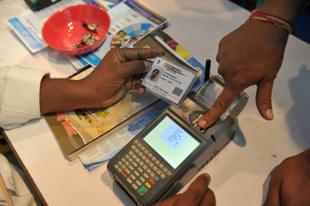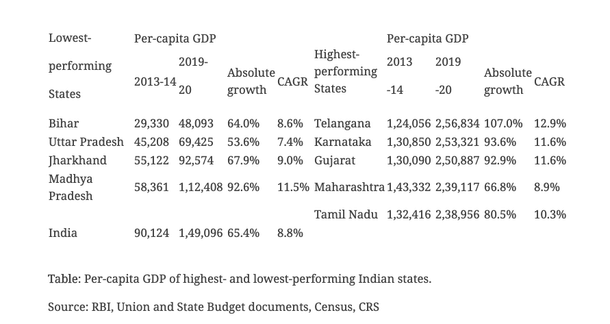Economy
India’s Poor Are Better Equipped To Handle A 21-Day Lockdown Today Than They Were In 2014
TV Mohandas Pai and Nisha Holla
Apr 05, 2020, 02:35 PM | Updated 02:35 PM IST
Save & read from anywhere!
Bookmark stories for easy access on any device or the Swarajya app.


The world is facing an unprecedented crisis today with the coronavirus pandemic.
India is staying ahead of the curve by the decisive actions of the government to screen international passengers actively as soon as the first positive Indian case became known on 30 January 2020, enforce quarantine measures, the Janata Curfew on 22 March (when Prime Minister Narendra Modi personally appealed to the general public to self-quarantine for the sake of public health), and now the proactive 21-day lockdown to curb the spread of the disease.
The impact of the 21-day lockdown—and the subsequent halt of economic activities—will be felt most strongly on the country’s poor and disadvantaged, particularly daily wage earners.
In an encouraging step, Finance Minister Nirmala Sitharaman announced a Rs 1.7 lakh crore stimulus package, including cash transfers for poor communities and food rations for 80 crore people for the next three months.
This DBT transfer for the bottom-of-the-pyramid of Rs 2,000 per month will prove vital, as discussed in our article on India’s required economic stimulus.
The RBI also announced relief measures for the economy, which are beneficial for maintaining financial stability, liquidity in the market and keeping more people on the payroll through the lockdown.
It is now pertinent to look at the state of the poor in India since NDA started in 2014.
Nominal GDP during FY’14 was Rs 112.3 lakh crore, amounting to a per-capita GDP of about Rs 90,124.
In FY’20, estimates from the Union Budget demonstrate India is at a nominal GDP of Rs 204.4 lakh crore (grown at a nominal CAGR of 10.5 per cent over six years), and per-capita GDP is Rs 1.49 lakh (See Table).

India’s top-performing states in per-capita GDP are Telangana, Karnataka, Gujarat, Maharashtra and Tamil Nadu. All these states have grown their nominal GDPs considerably by ramping up the services and industry sectors.
On the lower end, Bihar has the lowest per-capita GDP at Rs 48,000.
Uttar Pradesh, despite ranking fifth in the country by economic output, ranks low, per-capita.
Madhya Pradesh has done a decent job with economic output by ramping up agricultural productivity. All the states on the lower end have substantial populations that must be systematically included in the formal sector to drive per-capita GDP up.
The per-capita income parameter has grown well since 2014 across all states. Most importantly, inflation is under control.
Inflation during NDA’s tenure has been much lower than during that of UPA-II, which means savings in constant prices have been protected.
While one could argue that the top 10 per cent have benefited from this growth, it is pretty evident that the bottom-of-the-pyramid too has seen extensive uplift from poverty.
The United Nations Development Program’s Human Development Reports (UNDP HDR) track 101 countries through the newly introduced Multidimensional Poverty Index (MPI).
Having followed these countries over a decade, the 2019 Global MPI report notes that India (and Cambodia) “reduced their MPI values the fastest—and they did not leave the poorest groups behind”.
Estimates by World Bank and IMF place the number of India’s poor (subsisting on less than $1.9/day) at 50 million in 2019—3.6 per cent of India’s population—compared to the official 2011 figure of 268 million—22.1 per cent of the population at the time.
PM Modi’s focus on ruthlessly eradicating poverty and bringing development to the doorstep of India’s most impoverished has succeeded, without a doubt.
The NITI-Aayog Aspirational District Program (NAADP) launched under PM Modi’s direction has been crucial in ensuring no community is left behind.
NAADP has launched a direct assault on poverty by identifying 115 districts across the country with the lowest per-capita income and human development indicators.
By directing Central and State programs and resources into NAADP, we are witnessing a dramatic improvement in growth, per-capita income, and quality of life in these districts.
Elevating the bottom districts to double-digit growth will contribute massively to India’s growth also.
So how did NDA achieve this? By ensuring every Indian has access to the basic necessities of life:
* A roof over their head: 1.84 crore homes were built post-2014, a majority of them in the rural areas.
* A toilet in the house: Individual household latrine (IHHL) coverage is now at 100 per cent, up from 38.7 per cent in 2014. 10.28 crore latrines have been built, and all 6.03 lakh villages across all states/UTs have been declared open defecation free.
* Power in their switches: 100 per cent electrification was achieved in 988 days, covering 17,181 villages, up from around 96.7 per cent in 2014. 2.62 crore poor households were electrified, and the work to provide reliable power continues. 36.2 crore LEDs have been distributed for cleaner and more efficient power utilisation.
* Food on the table: Food security coverage has been extended to all 36 states/UTs of India from just the 11 states/UTs in 2014 as per the National Food Security Act. Under this Act, the government is supplying 5 kg of food grain each per month to over 80 crore people at a highly subsidised price.
* Gas connection in the kitchen: 13 crore gas connections were distributed in five years, bringing the total to around 25 crore. 8.03 crore connections have been provided free to rural women, enabling them to cook smoke-free and improving their health dramatically.
* Rural road connectivity: Today, 97 per cent of villages are connected with roads, up from 56 per cent in 2014, with 1.8 lakh km built since FY15.
* Access to education: Apart from schools, enrolment in higher education has also jumped from 3.23 crore in 2014 to 3.74 crore in 2019. More Indians, including women, are aspiring to become graduates. The Gross Enrolment Ratio of women has risen from 22.0 in 2014 to 26.4 in 2019, overtaking men for the first time last year. It is essential to create more formal jobs for all of them now.
* Mobile phones: TRAI data shows the wireless subscriber base in December 2019 was 1.15 billion, up from 0.9 billion in 2014. Of this, 507.5 million are in rural areas. Access to cellular has transformed how people in rural areas do business and earn a livelihood.
* Access to the internet and digital platforms: The internet subscriber base, per TRAI, has increased from 251.6 million in 2014 to 661.9 million in March 2019. Apart from this, 1.37 lakh gram panchayats have been connected with optical fibre for citizens to access their bank accounts and DBT digitally.
* Bank accounts: Through the Jan Dhan Yojana, 38.3 crore bank accounts were opened. Total deposits have crossed Rs 1.18 lakh crore. Over 53 per cent of holders are women.
* Direct Beneficiary Transfer: DBT has enabled the government to provide Rs 9.55 lakh crore over 427 schemes to date, directly to citizens’ Jan Dhan bank accounts. 9.21 crore farmer-beneficiaries are registered on the system.
* Small business loans: Through Mudra, loans worth more than Rs 10 lakh crore have been disbursed to more than 24 crore beneficiaries, as of February 2020, to start their own businesses and aspire for a better life
* Insurance cover: Since 2014, more than 28 crore people have availed insurance for accident and disability coverage, life insurance, and so on.
* Farmers: Over 14.24 crore insurance covers have been provided with increased distress relief for crop damage. 9.21 crore farmers directly benefit from the PM Kisan Samman Nidhi scheme, where they receive Rs 6,000 per year minimum income support.
* Affordable healthcare: Ayushman Bharat was launched in September 2018 to provide a health insurance cover of Rs 5 lakh/family/year. As of March 2020, over 93 lakh people have availed medical treatment worth over Rs 9,205 crore. The plan is to benefit 50 crore citizens, with 12.4 crore e-cards issued.
* Maternal and child healthcare has dramatically improved through Intensified Mission Indradhanush, which immunised 86.88 lakh pregnant women and 3.38 crore children, as of June 2019.
There has been a substantial decrease in the infant mortality rate—from 36.9 per 1,000 live births in 2014 down to 29.9 per 1,000 in 2018, per World Bank estimates.
Similarly, maternal mortality rates have persistently declined YoY too; Union Health Minister Dr Harsh Vardhan announced in November 2019 that “India is on track to achieving the (WHO) Sustainable Development Goal target for reducing MMR by 2025, five years ahead of timeline of 2030”.
* Maternity benefits: Matru Vandana Yojana has provided maternity benefits worth Rs 4,989 crore to 1.35 crore women, as of March 2020.
* Clean water: While piped water supply hasn’t reached everyone yet, this is one of the first mandates taken up by the NDA government
(Source: 5years.mygov, TRAI, AISHE, Economic Times, pmjay.gov)
The data is clear—no prime minister in the history of independent India has done more for the country’s poor and disadvantaged as PM Modi did in his first five-year term from 2014-2019.
Unprecendented
The development performance by PM Modi and NDA is unprecedented and is the primary reason he was voted back to power in 2019.
The NDA returned with a governance mandate of 353 seats in May 2019, with BJP itself at 303 seats—a thumping majority.
In the run-up to the elections last year, the Lutyens media ran a vicious campaign against him, predicting with 100 per cent certainty that he would not win again. They clearly missed how much he had helped the poor rise from abject poverty.
However, the people recognised that they had a Prime Minister who was genuinely concerned about them, who had delivered on his mandate and had fulfilled his commitment to lift them out of poverty.
The coronavirus epidemic will mark an inflection point in India.
Today, we can safely say we are in a significantly better position to face an unprecedented 21-day lockdown compared to 2014—given that so many Indians have markedly improved security in 2020.
This is, of course, subject to the fact that the markets for essential commodities and liquidity are kept open and accessible to citizens, and enough is done to keep MSMEs and employers solvent through a supportive stimulus. A programme for income support to the bottom-of-the-pyramid is essential.
It is evident that India’s poor today are in a more favourable position to weather crises like a 21-day lockdown and a rapid-transmission pandemic than before, with so many fundamentals improved over the prior half-decade.
We are at an intriguing juncture to rethink how India will face the future. Under PM Modi, we have created an extensive electronic infrastructure which connects most Indians, enables fast digital payments through UPI, delivers direct benefits electronically, and facilitates productivity leaps.
With the JAM or India Stack, there has been a dramatic increase in digital transactions, of people on the internet, DBT beneficiaries, the opening of bank accounts and more.
This will empower every Indian at a time when the country is physically locked up and face-to-face interaction may be life-threatening.
Without this inclusive electronic network, there is no doubt India—and particularly India’s poor—would have been worse off.
PM Modi’s foresight in creating this electronic network and connecting every Indian provides a robust bulwark to withstand a crisis of this magnitude.
The next step is to further utilise this unique next-gen system to re-engineer the delivery of subsidies and help BPL families more efficiently.
In parallel, we must invest in human capital development to generate more formal, high-quality jobs.
This move will facilitate the transition of the workforce from agriculture to industry and services—thereby accelerating personal prosperity for more people, strengthening the resilience of India’s families, cementing our position as a Top Three economy, and eliminating poverty completely.
This article was first published on The Sunday Guardian and has been republished here with permission.
TV Mohandas Pai is Chairman, Aarin Capital Partners and Nisha Holla is Technology Fellow, C-CAMP.



